Change Management Essay: Leading Change and Transformation Failures
VerifiedAdded on 2023/06/10
|9
|2516
|117
Essay
AI Summary
This essay delves into the complexities of change management, focusing on the reasons behind the frequent failures of transformation efforts within organizations. It explores various change management models and theories, including Kotter's theory, Lewin's change management model, and the McKinsey 7-S model, to understand the critical factors influencing the success or failure of change initiatives. The essay examines real-world examples of failed change processes, such as the New Coke launch by Coca-Cola and the case of Motorola, to illustrate the practical implications of these theories. It highlights common pitfalls like a lack of urgency, inadequate leadership, unclear vision, poor communication, and the failure to secure short-term wins and connect successes with new behaviors. The analysis emphasizes the importance of a systematic approach to change management, incorporating appropriate strategies, effective execution, and stakeholder engagement to navigate the challenges of a dynamic market environment and changing consumer behavior.
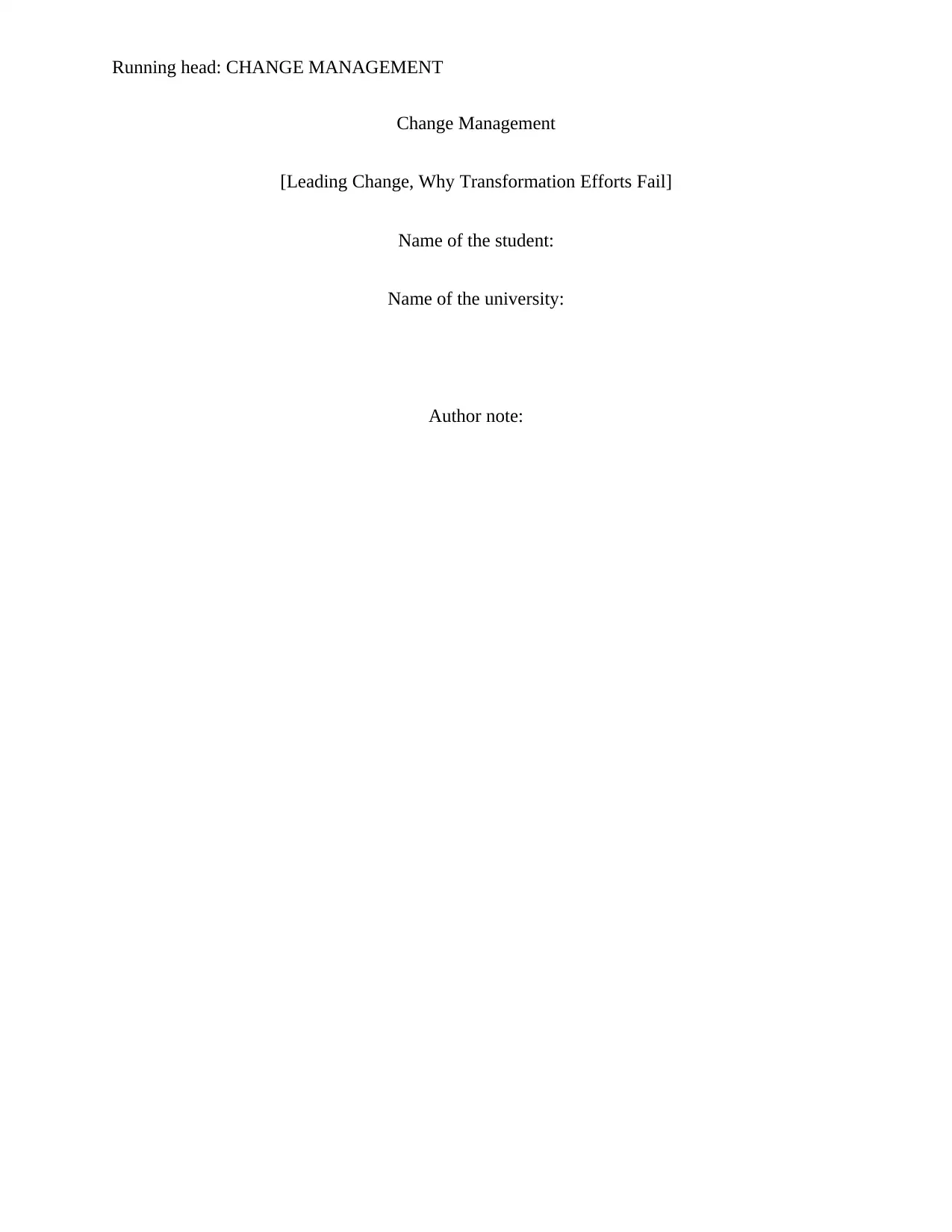
Running head: CHANGE MANAGEMENT
Change Management
[Leading Change, Why Transformation Efforts Fail]
Name of the student:
Name of the university:
Author note:
Change Management
[Leading Change, Why Transformation Efforts Fail]
Name of the student:
Name of the university:
Author note:
Paraphrase This Document
Need a fresh take? Get an instant paraphrase of this document with our AI Paraphraser
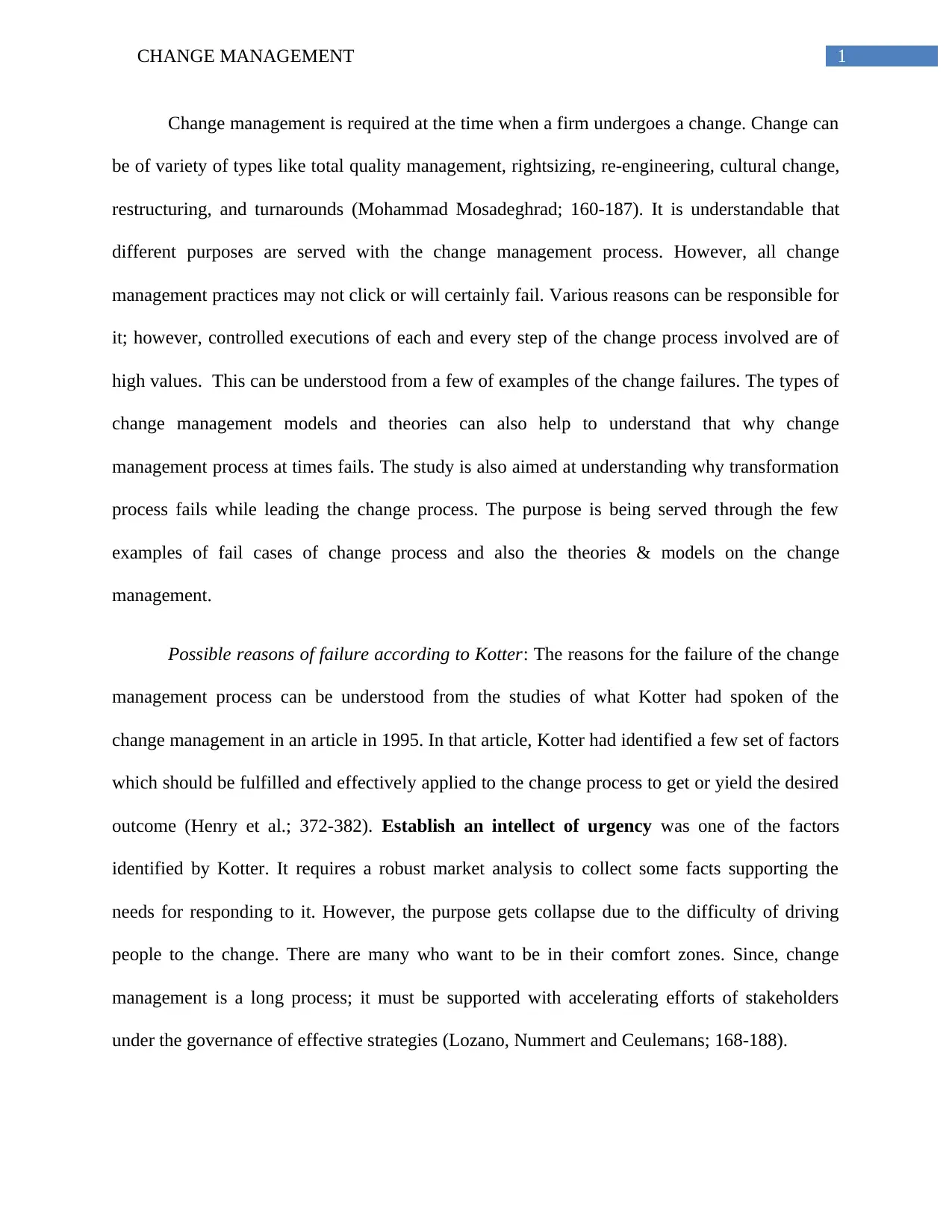
1CHANGE MANAGEMENT
Change management is required at the time when a firm undergoes a change. Change can
be of variety of types like total quality management, rightsizing, re-engineering, cultural change,
restructuring, and turnarounds (Mohammad Mosadeghrad; 160-187). It is understandable that
different purposes are served with the change management process. However, all change
management practices may not click or will certainly fail. Various reasons can be responsible for
it; however, controlled executions of each and every step of the change process involved are of
high values. This can be understood from a few of examples of the change failures. The types of
change management models and theories can also help to understand that why change
management process at times fails. The study is also aimed at understanding why transformation
process fails while leading the change process. The purpose is being served through the few
examples of fail cases of change process and also the theories & models on the change
management.
Possible reasons of failure according to Kotter: The reasons for the failure of the change
management process can be understood from the studies of what Kotter had spoken of the
change management in an article in 1995. In that article, Kotter had identified a few set of factors
which should be fulfilled and effectively applied to the change process to get or yield the desired
outcome (Henry et al.; 372-382). Establish an intellect of urgency was one of the factors
identified by Kotter. It requires a robust market analysis to collect some facts supporting the
needs for responding to it. However, the purpose gets collapse due to the difficulty of driving
people to the change. There are many who want to be in their comfort zones. Since, change
management is a long process; it must be supported with accelerating efforts of stakeholders
under the governance of effective strategies (Lozano, Nummert and Ceulemans; 168-188).
Change management is required at the time when a firm undergoes a change. Change can
be of variety of types like total quality management, rightsizing, re-engineering, cultural change,
restructuring, and turnarounds (Mohammad Mosadeghrad; 160-187). It is understandable that
different purposes are served with the change management process. However, all change
management practices may not click or will certainly fail. Various reasons can be responsible for
it; however, controlled executions of each and every step of the change process involved are of
high values. This can be understood from a few of examples of the change failures. The types of
change management models and theories can also help to understand that why change
management process at times fails. The study is also aimed at understanding why transformation
process fails while leading the change process. The purpose is being served through the few
examples of fail cases of change process and also the theories & models on the change
management.
Possible reasons of failure according to Kotter: The reasons for the failure of the change
management process can be understood from the studies of what Kotter had spoken of the
change management in an article in 1995. In that article, Kotter had identified a few set of factors
which should be fulfilled and effectively applied to the change process to get or yield the desired
outcome (Henry et al.; 372-382). Establish an intellect of urgency was one of the factors
identified by Kotter. It requires a robust market analysis to collect some facts supporting the
needs for responding to it. However, the purpose gets collapse due to the difficulty of driving
people to the change. There are many who want to be in their comfort zones. Since, change
management is a long process; it must be supported with accelerating efforts of stakeholders
under the governance of effective strategies (Lozano, Nummert and Ceulemans; 168-188).
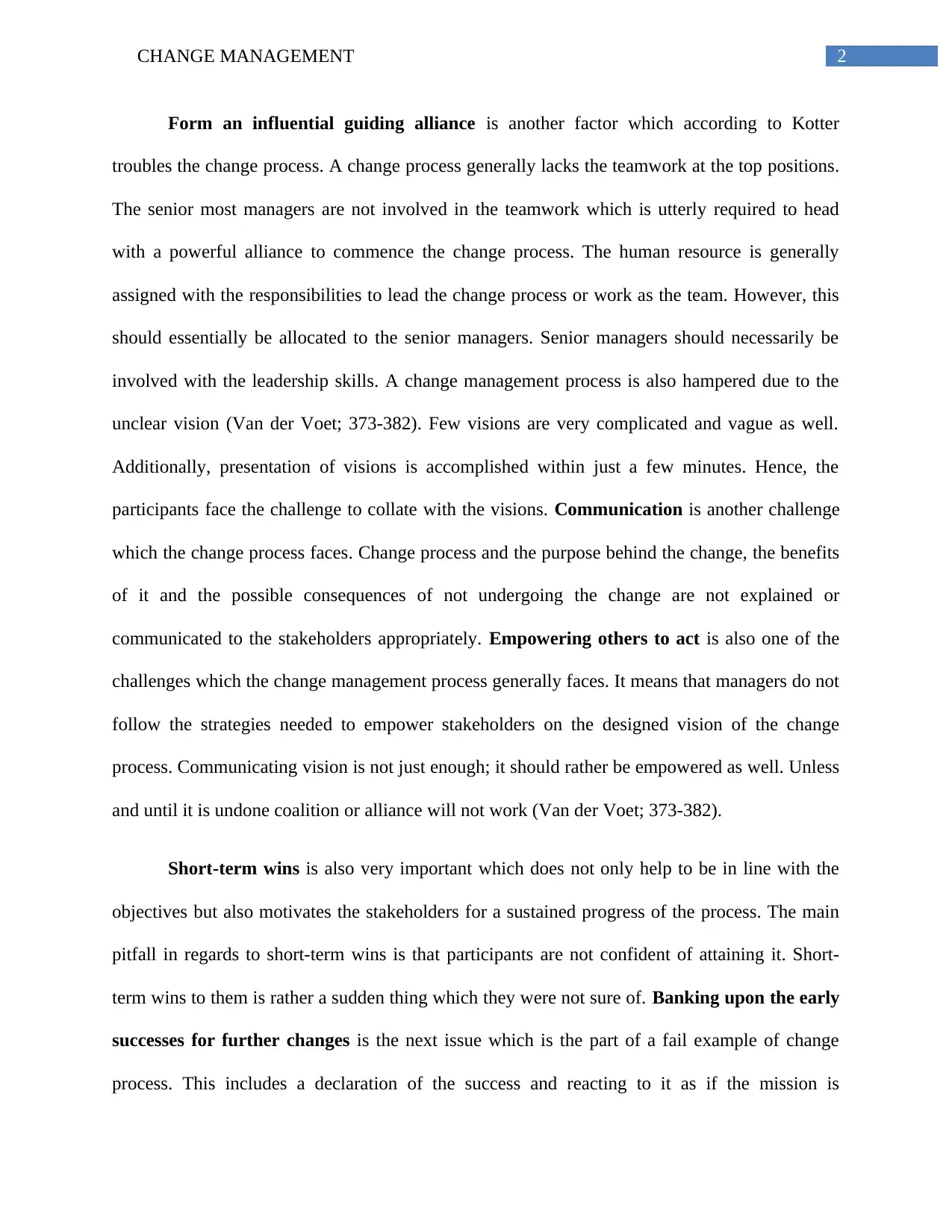
2CHANGE MANAGEMENT
Form an influential guiding alliance is another factor which according to Kotter
troubles the change process. A change process generally lacks the teamwork at the top positions.
The senior most managers are not involved in the teamwork which is utterly required to head
with a powerful alliance to commence the change process. The human resource is generally
assigned with the responsibilities to lead the change process or work as the team. However, this
should essentially be allocated to the senior managers. Senior managers should necessarily be
involved with the leadership skills. A change management process is also hampered due to the
unclear vision (Van der Voet; 373-382). Few visions are very complicated and vague as well.
Additionally, presentation of visions is accomplished within just a few minutes. Hence, the
participants face the challenge to collate with the visions. Communication is another challenge
which the change process faces. Change process and the purpose behind the change, the benefits
of it and the possible consequences of not undergoing the change are not explained or
communicated to the stakeholders appropriately. Empowering others to act is also one of the
challenges which the change management process generally faces. It means that managers do not
follow the strategies needed to empower stakeholders on the designed vision of the change
process. Communicating vision is not just enough; it should rather be empowered as well. Unless
and until it is undone coalition or alliance will not work (Van der Voet; 373-382).
Short-term wins is also very important which does not only help to be in line with the
objectives but also motivates the stakeholders for a sustained progress of the process. The main
pitfall in regards to short-term wins is that participants are not confident of attaining it. Short-
term wins to them is rather a sudden thing which they were not sure of. Banking upon the early
successes for further changes is the next issue which is the part of a fail example of change
process. This includes a declaration of the success and reacting to it as if the mission is
Form an influential guiding alliance is another factor which according to Kotter
troubles the change process. A change process generally lacks the teamwork at the top positions.
The senior most managers are not involved in the teamwork which is utterly required to head
with a powerful alliance to commence the change process. The human resource is generally
assigned with the responsibilities to lead the change process or work as the team. However, this
should essentially be allocated to the senior managers. Senior managers should necessarily be
involved with the leadership skills. A change management process is also hampered due to the
unclear vision (Van der Voet; 373-382). Few visions are very complicated and vague as well.
Additionally, presentation of visions is accomplished within just a few minutes. Hence, the
participants face the challenge to collate with the visions. Communication is another challenge
which the change process faces. Change process and the purpose behind the change, the benefits
of it and the possible consequences of not undergoing the change are not explained or
communicated to the stakeholders appropriately. Empowering others to act is also one of the
challenges which the change management process generally faces. It means that managers do not
follow the strategies needed to empower stakeholders on the designed vision of the change
process. Communicating vision is not just enough; it should rather be empowered as well. Unless
and until it is undone coalition or alliance will not work (Van der Voet; 373-382).
Short-term wins is also very important which does not only help to be in line with the
objectives but also motivates the stakeholders for a sustained progress of the process. The main
pitfall in regards to short-term wins is that participants are not confident of attaining it. Short-
term wins to them is rather a sudden thing which they were not sure of. Banking upon the early
successes for further changes is the next issue which is the part of a fail example of change
process. This includes a declaration of the success and reacting to it as if the mission is
⊘ This is a preview!⊘
Do you want full access?
Subscribe today to unlock all pages.

Trusted by 1+ million students worldwide
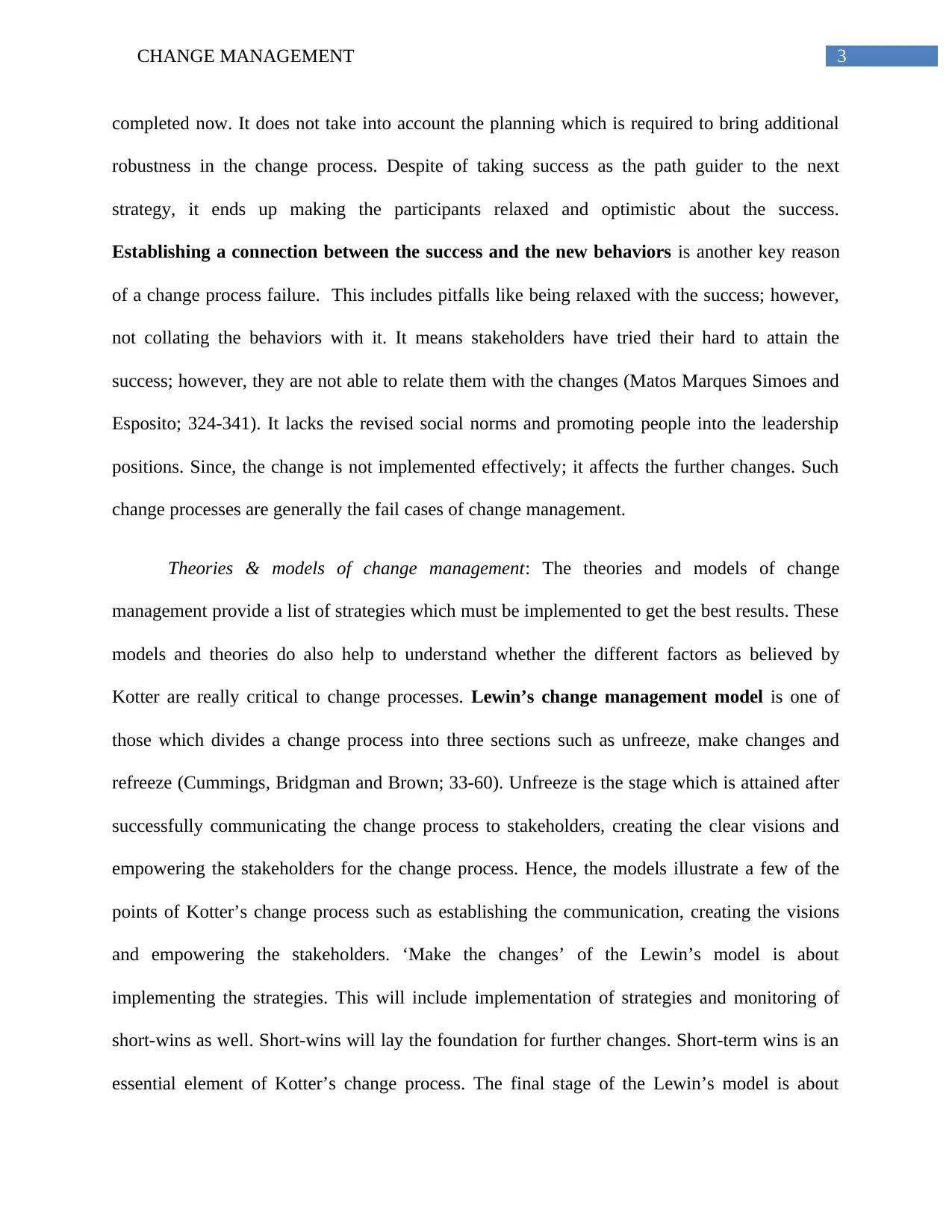
3CHANGE MANAGEMENT
completed now. It does not take into account the planning which is required to bring additional
robustness in the change process. Despite of taking success as the path guider to the next
strategy, it ends up making the participants relaxed and optimistic about the success.
Establishing a connection between the success and the new behaviors is another key reason
of a change process failure. This includes pitfalls like being relaxed with the success; however,
not collating the behaviors with it. It means stakeholders have tried their hard to attain the
success; however, they are not able to relate them with the changes (Matos Marques Simoes and
Esposito; 324-341). It lacks the revised social norms and promoting people into the leadership
positions. Since, the change is not implemented effectively; it affects the further changes. Such
change processes are generally the fail cases of change management.
Theories & models of change management: The theories and models of change
management provide a list of strategies which must be implemented to get the best results. These
models and theories do also help to understand whether the different factors as believed by
Kotter are really critical to change processes. Lewin’s change management model is one of
those which divides a change process into three sections such as unfreeze, make changes and
refreeze (Cummings, Bridgman and Brown; 33-60). Unfreeze is the stage which is attained after
successfully communicating the change process to stakeholders, creating the clear visions and
empowering the stakeholders for the change process. Hence, the models illustrate a few of the
points of Kotter’s change process such as establishing the communication, creating the visions
and empowering the stakeholders. ‘Make the changes’ of the Lewin’s model is about
implementing the strategies. This will include implementation of strategies and monitoring of
short-wins as well. Short-wins will lay the foundation for further changes. Short-term wins is an
essential element of Kotter’s change process. The final stage of the Lewin’s model is about
completed now. It does not take into account the planning which is required to bring additional
robustness in the change process. Despite of taking success as the path guider to the next
strategy, it ends up making the participants relaxed and optimistic about the success.
Establishing a connection between the success and the new behaviors is another key reason
of a change process failure. This includes pitfalls like being relaxed with the success; however,
not collating the behaviors with it. It means stakeholders have tried their hard to attain the
success; however, they are not able to relate them with the changes (Matos Marques Simoes and
Esposito; 324-341). It lacks the revised social norms and promoting people into the leadership
positions. Since, the change is not implemented effectively; it affects the further changes. Such
change processes are generally the fail cases of change management.
Theories & models of change management: The theories and models of change
management provide a list of strategies which must be implemented to get the best results. These
models and theories do also help to understand whether the different factors as believed by
Kotter are really critical to change processes. Lewin’s change management model is one of
those which divides a change process into three sections such as unfreeze, make changes and
refreeze (Cummings, Bridgman and Brown; 33-60). Unfreeze is the stage which is attained after
successfully communicating the change process to stakeholders, creating the clear visions and
empowering the stakeholders for the change process. Hence, the models illustrate a few of the
points of Kotter’s change process such as establishing the communication, creating the visions
and empowering the stakeholders. ‘Make the changes’ of the Lewin’s model is about
implementing the strategies. This will include implementation of strategies and monitoring of
short-wins as well. Short-wins will lay the foundation for further changes. Short-term wins is an
essential element of Kotter’s change process. The final stage of the Lewin’s model is about
Paraphrase This Document
Need a fresh take? Get an instant paraphrase of this document with our AI Paraphraser
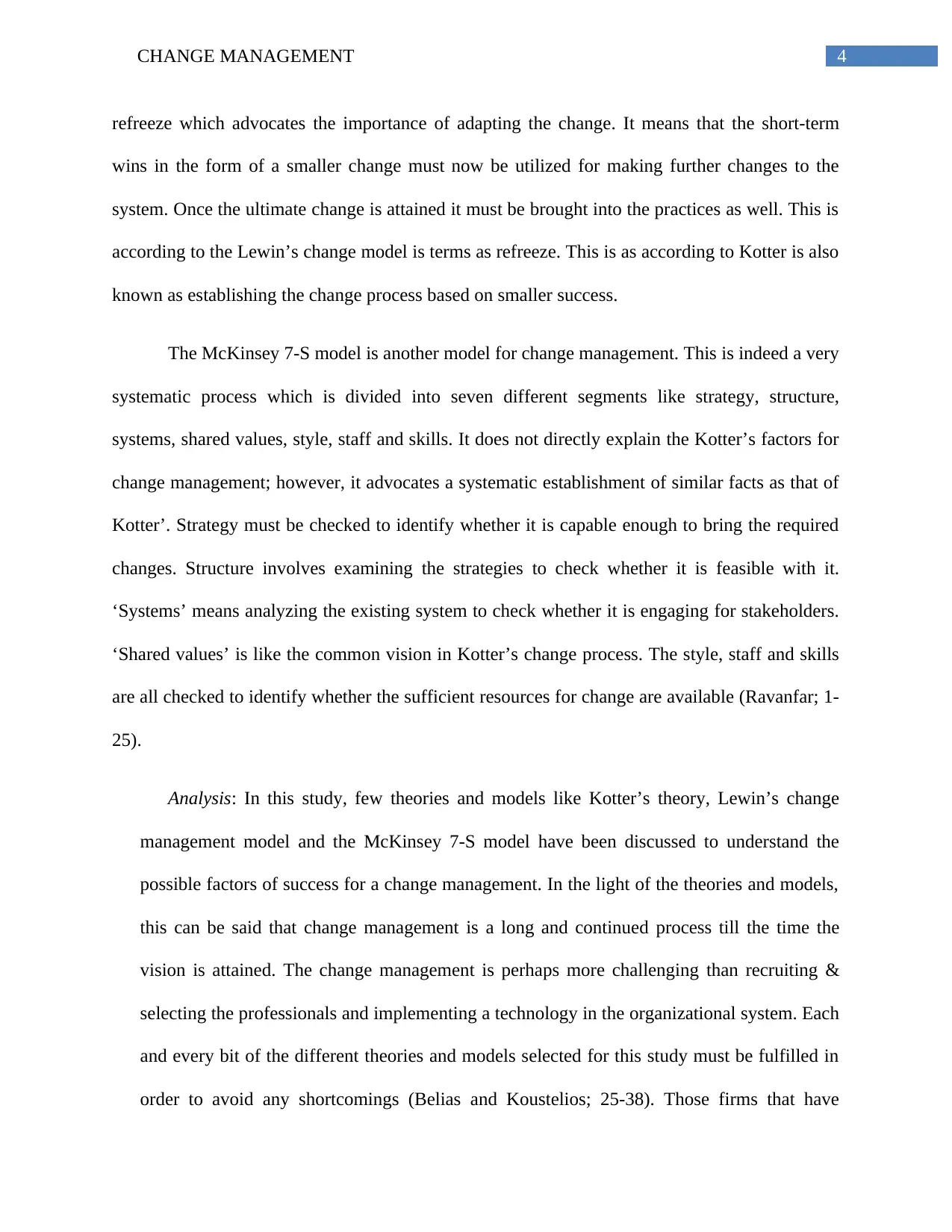
4CHANGE MANAGEMENT
refreeze which advocates the importance of adapting the change. It means that the short-term
wins in the form of a smaller change must now be utilized for making further changes to the
system. Once the ultimate change is attained it must be brought into the practices as well. This is
according to the Lewin’s change model is terms as refreeze. This is as according to Kotter is also
known as establishing the change process based on smaller success.
The McKinsey 7-S model is another model for change management. This is indeed a very
systematic process which is divided into seven different segments like strategy, structure,
systems, shared values, style, staff and skills. It does not directly explain the Kotter’s factors for
change management; however, it advocates a systematic establishment of similar facts as that of
Kotter’. Strategy must be checked to identify whether it is capable enough to bring the required
changes. Structure involves examining the strategies to check whether it is feasible with it.
‘Systems’ means analyzing the existing system to check whether it is engaging for stakeholders.
‘Shared values’ is like the common vision in Kotter’s change process. The style, staff and skills
are all checked to identify whether the sufficient resources for change are available (Ravanfar; 1-
25).
Analysis: In this study, few theories and models like Kotter’s theory, Lewin’s change
management model and the McKinsey 7-S model have been discussed to understand the
possible factors of success for a change management. In the light of the theories and models,
this can be said that change management is a long and continued process till the time the
vision is attained. The change management is perhaps more challenging than recruiting &
selecting the professionals and implementing a technology in the organizational system. Each
and every bit of the different theories and models selected for this study must be fulfilled in
order to avoid any shortcomings (Belias and Koustelios; 25-38). Those firms that have
refreeze which advocates the importance of adapting the change. It means that the short-term
wins in the form of a smaller change must now be utilized for making further changes to the
system. Once the ultimate change is attained it must be brought into the practices as well. This is
according to the Lewin’s change model is terms as refreeze. This is as according to Kotter is also
known as establishing the change process based on smaller success.
The McKinsey 7-S model is another model for change management. This is indeed a very
systematic process which is divided into seven different segments like strategy, structure,
systems, shared values, style, staff and skills. It does not directly explain the Kotter’s factors for
change management; however, it advocates a systematic establishment of similar facts as that of
Kotter’. Strategy must be checked to identify whether it is capable enough to bring the required
changes. Structure involves examining the strategies to check whether it is feasible with it.
‘Systems’ means analyzing the existing system to check whether it is engaging for stakeholders.
‘Shared values’ is like the common vision in Kotter’s change process. The style, staff and skills
are all checked to identify whether the sufficient resources for change are available (Ravanfar; 1-
25).
Analysis: In this study, few theories and models like Kotter’s theory, Lewin’s change
management model and the McKinsey 7-S model have been discussed to understand the
possible factors of success for a change management. In the light of the theories and models,
this can be said that change management is a long and continued process till the time the
vision is attained. The change management is perhaps more challenging than recruiting &
selecting the professionals and implementing a technology in the organizational system. Each
and every bit of the different theories and models selected for this study must be fulfilled in
order to avoid any shortcomings (Belias and Koustelios; 25-38). Those firms that have
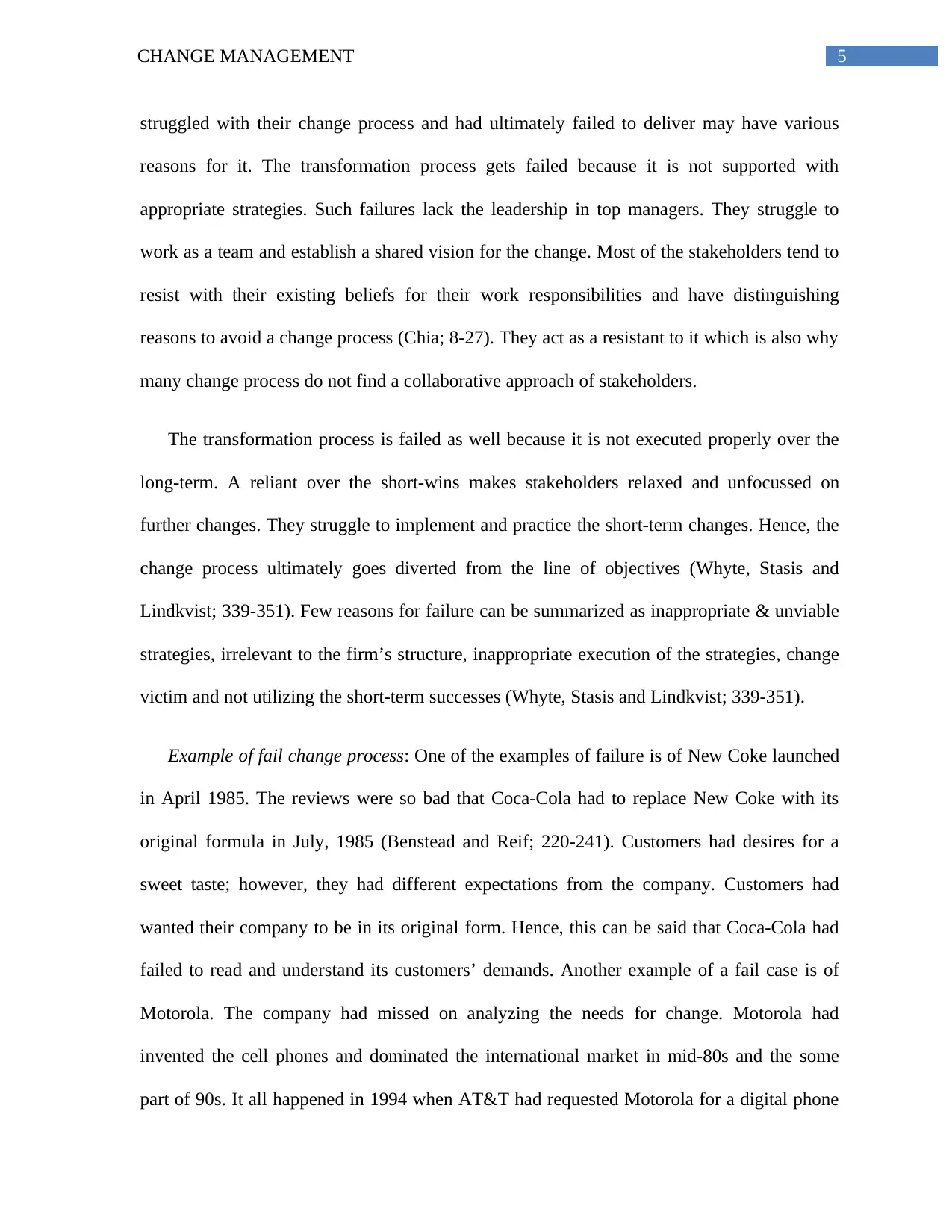
5CHANGE MANAGEMENT
struggled with their change process and had ultimately failed to deliver may have various
reasons for it. The transformation process gets failed because it is not supported with
appropriate strategies. Such failures lack the leadership in top managers. They struggle to
work as a team and establish a shared vision for the change. Most of the stakeholders tend to
resist with their existing beliefs for their work responsibilities and have distinguishing
reasons to avoid a change process (Chia; 8-27). They act as a resistant to it which is also why
many change process do not find a collaborative approach of stakeholders.
The transformation process is failed as well because it is not executed properly over the
long-term. A reliant over the short-wins makes stakeholders relaxed and unfocussed on
further changes. They struggle to implement and practice the short-term changes. Hence, the
change process ultimately goes diverted from the line of objectives (Whyte, Stasis and
Lindkvist; 339-351). Few reasons for failure can be summarized as inappropriate & unviable
strategies, irrelevant to the firm’s structure, inappropriate execution of the strategies, change
victim and not utilizing the short-term successes (Whyte, Stasis and Lindkvist; 339-351).
Example of fail change process: One of the examples of failure is of New Coke launched
in April 1985. The reviews were so bad that Coca-Cola had to replace New Coke with its
original formula in July, 1985 (Benstead and Reif; 220-241). Customers had desires for a
sweet taste; however, they had different expectations from the company. Customers had
wanted their company to be in its original form. Hence, this can be said that Coca-Cola had
failed to read and understand its customers’ demands. Another example of a fail case is of
Motorola. The company had missed on analyzing the needs for change. Motorola had
invented the cell phones and dominated the international market in mid-80s and the some
part of 90s. It all happened in 1994 when AT&T had requested Motorola for a digital phone
struggled with their change process and had ultimately failed to deliver may have various
reasons for it. The transformation process gets failed because it is not supported with
appropriate strategies. Such failures lack the leadership in top managers. They struggle to
work as a team and establish a shared vision for the change. Most of the stakeholders tend to
resist with their existing beliefs for their work responsibilities and have distinguishing
reasons to avoid a change process (Chia; 8-27). They act as a resistant to it which is also why
many change process do not find a collaborative approach of stakeholders.
The transformation process is failed as well because it is not executed properly over the
long-term. A reliant over the short-wins makes stakeholders relaxed and unfocussed on
further changes. They struggle to implement and practice the short-term changes. Hence, the
change process ultimately goes diverted from the line of objectives (Whyte, Stasis and
Lindkvist; 339-351). Few reasons for failure can be summarized as inappropriate & unviable
strategies, irrelevant to the firm’s structure, inappropriate execution of the strategies, change
victim and not utilizing the short-term successes (Whyte, Stasis and Lindkvist; 339-351).
Example of fail change process: One of the examples of failure is of New Coke launched
in April 1985. The reviews were so bad that Coca-Cola had to replace New Coke with its
original formula in July, 1985 (Benstead and Reif; 220-241). Customers had desires for a
sweet taste; however, they had different expectations from the company. Customers had
wanted their company to be in its original form. Hence, this can be said that Coca-Cola had
failed to read and understand its customers’ demands. Another example of a fail case is of
Motorola. The company had missed on analyzing the needs for change. Motorola had
invented the cell phones and dominated the international market in mid-80s and the some
part of 90s. It all happened in 1994 when AT&T had requested Motorola for a digital phone
⊘ This is a preview!⊘
Do you want full access?
Subscribe today to unlock all pages.

Trusted by 1+ million students worldwide
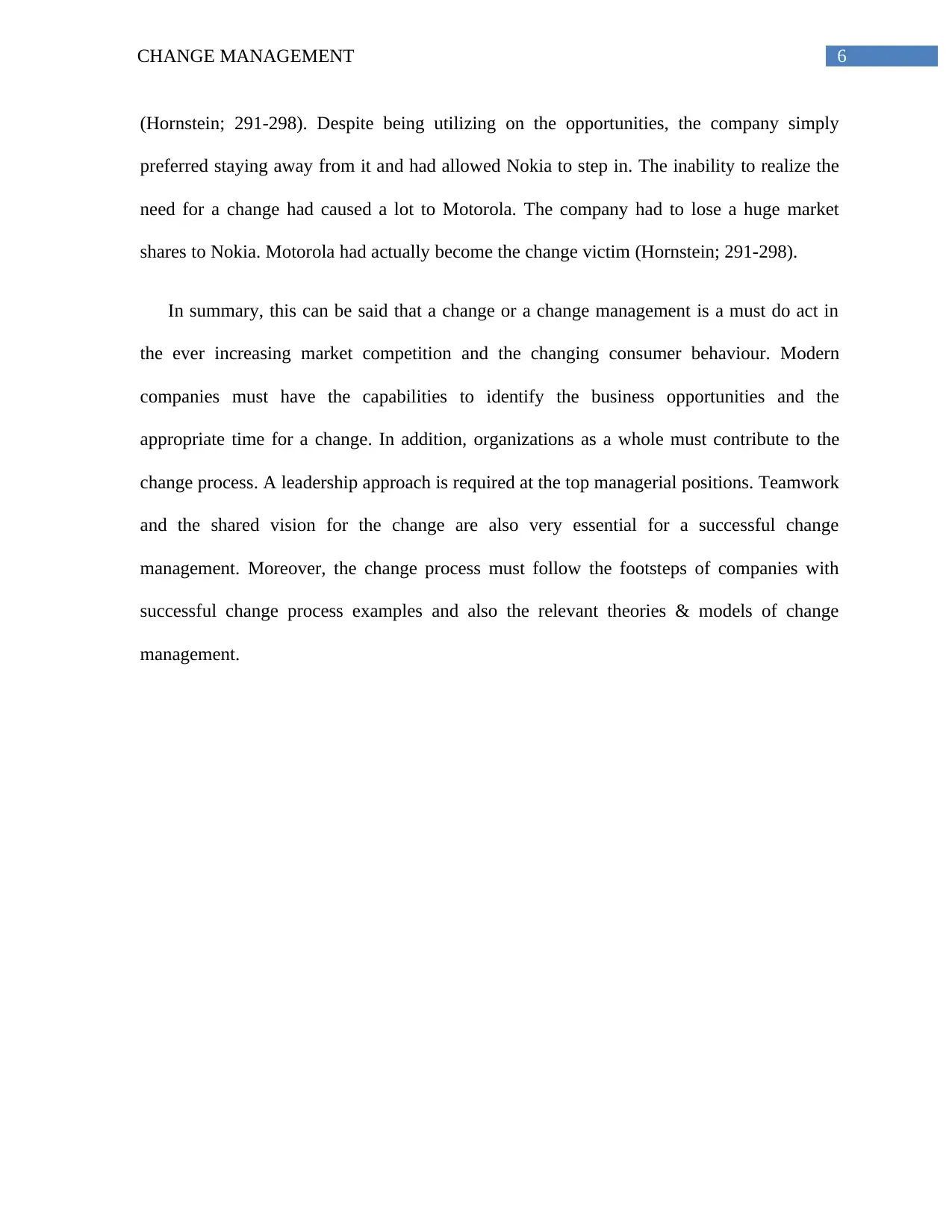
6CHANGE MANAGEMENT
(Hornstein; 291-298). Despite being utilizing on the opportunities, the company simply
preferred staying away from it and had allowed Nokia to step in. The inability to realize the
need for a change had caused a lot to Motorola. The company had to lose a huge market
shares to Nokia. Motorola had actually become the change victim (Hornstein; 291-298).
In summary, this can be said that a change or a change management is a must do act in
the ever increasing market competition and the changing consumer behaviour. Modern
companies must have the capabilities to identify the business opportunities and the
appropriate time for a change. In addition, organizations as a whole must contribute to the
change process. A leadership approach is required at the top managerial positions. Teamwork
and the shared vision for the change are also very essential for a successful change
management. Moreover, the change process must follow the footsteps of companies with
successful change process examples and also the relevant theories & models of change
management.
(Hornstein; 291-298). Despite being utilizing on the opportunities, the company simply
preferred staying away from it and had allowed Nokia to step in. The inability to realize the
need for a change had caused a lot to Motorola. The company had to lose a huge market
shares to Nokia. Motorola had actually become the change victim (Hornstein; 291-298).
In summary, this can be said that a change or a change management is a must do act in
the ever increasing market competition and the changing consumer behaviour. Modern
companies must have the capabilities to identify the business opportunities and the
appropriate time for a change. In addition, organizations as a whole must contribute to the
change process. A leadership approach is required at the top managerial positions. Teamwork
and the shared vision for the change are also very essential for a successful change
management. Moreover, the change process must follow the footsteps of companies with
successful change process examples and also the relevant theories & models of change
management.
Paraphrase This Document
Need a fresh take? Get an instant paraphrase of this document with our AI Paraphraser
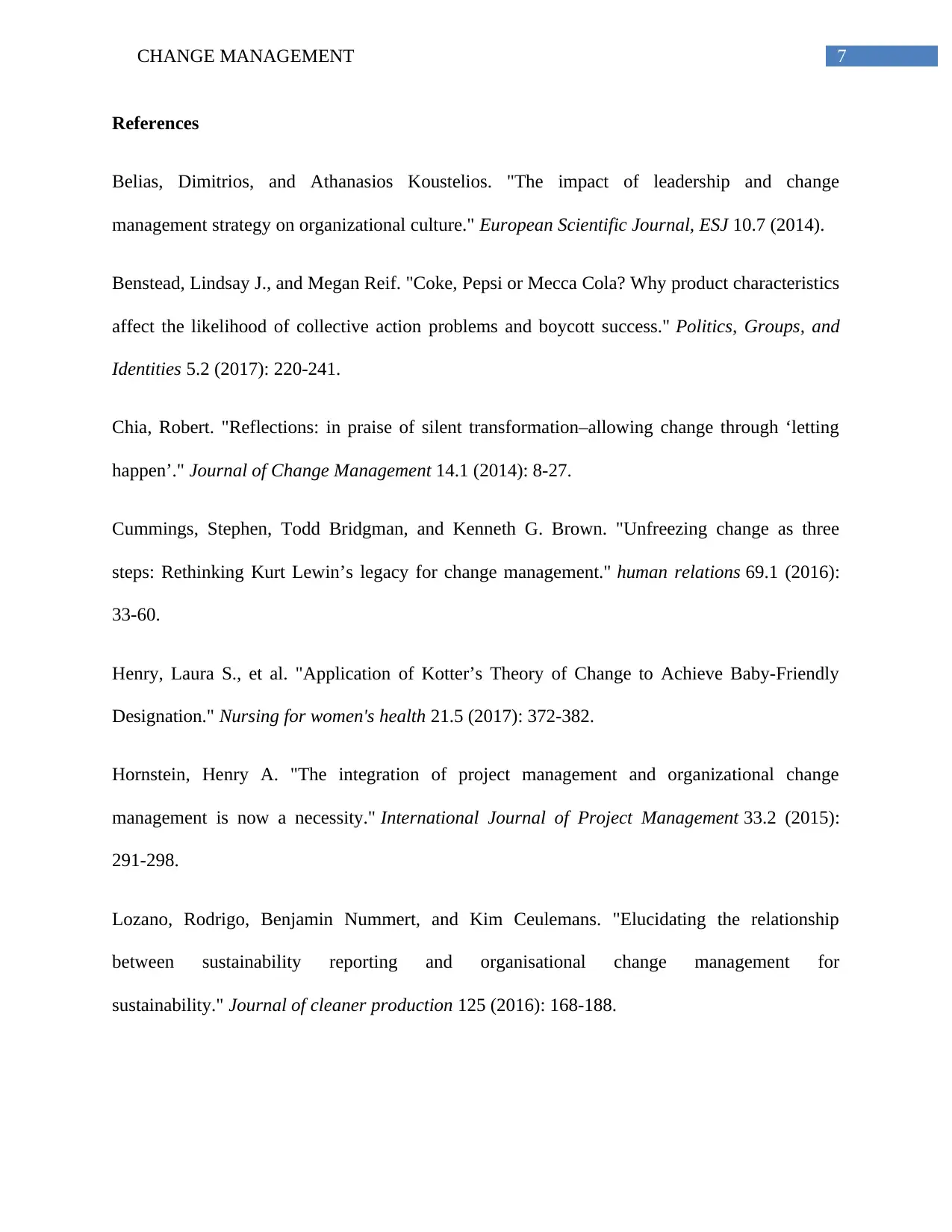
7CHANGE MANAGEMENT
References
Belias, Dimitrios, and Athanasios Koustelios. "The impact of leadership and change
management strategy on organizational culture." European Scientific Journal, ESJ 10.7 (2014).
Benstead, Lindsay J., and Megan Reif. "Coke, Pepsi or Mecca Cola? Why product characteristics
affect the likelihood of collective action problems and boycott success." Politics, Groups, and
Identities 5.2 (2017): 220-241.
Chia, Robert. "Reflections: in praise of silent transformation–allowing change through ‘letting
happen’." Journal of Change Management 14.1 (2014): 8-27.
Cummings, Stephen, Todd Bridgman, and Kenneth G. Brown. "Unfreezing change as three
steps: Rethinking Kurt Lewin’s legacy for change management." human relations 69.1 (2016):
33-60.
Henry, Laura S., et al. "Application of Kotter’s Theory of Change to Achieve Baby-Friendly
Designation." Nursing for women's health 21.5 (2017): 372-382.
Hornstein, Henry A. "The integration of project management and organizational change
management is now a necessity." International Journal of Project Management 33.2 (2015):
291-298.
Lozano, Rodrigo, Benjamin Nummert, and Kim Ceulemans. "Elucidating the relationship
between sustainability reporting and organisational change management for
sustainability." Journal of cleaner production 125 (2016): 168-188.
References
Belias, Dimitrios, and Athanasios Koustelios. "The impact of leadership and change
management strategy on organizational culture." European Scientific Journal, ESJ 10.7 (2014).
Benstead, Lindsay J., and Megan Reif. "Coke, Pepsi or Mecca Cola? Why product characteristics
affect the likelihood of collective action problems and boycott success." Politics, Groups, and
Identities 5.2 (2017): 220-241.
Chia, Robert. "Reflections: in praise of silent transformation–allowing change through ‘letting
happen’." Journal of Change Management 14.1 (2014): 8-27.
Cummings, Stephen, Todd Bridgman, and Kenneth G. Brown. "Unfreezing change as three
steps: Rethinking Kurt Lewin’s legacy for change management." human relations 69.1 (2016):
33-60.
Henry, Laura S., et al. "Application of Kotter’s Theory of Change to Achieve Baby-Friendly
Designation." Nursing for women's health 21.5 (2017): 372-382.
Hornstein, Henry A. "The integration of project management and organizational change
management is now a necessity." International Journal of Project Management 33.2 (2015):
291-298.
Lozano, Rodrigo, Benjamin Nummert, and Kim Ceulemans. "Elucidating the relationship
between sustainability reporting and organisational change management for
sustainability." Journal of cleaner production 125 (2016): 168-188.
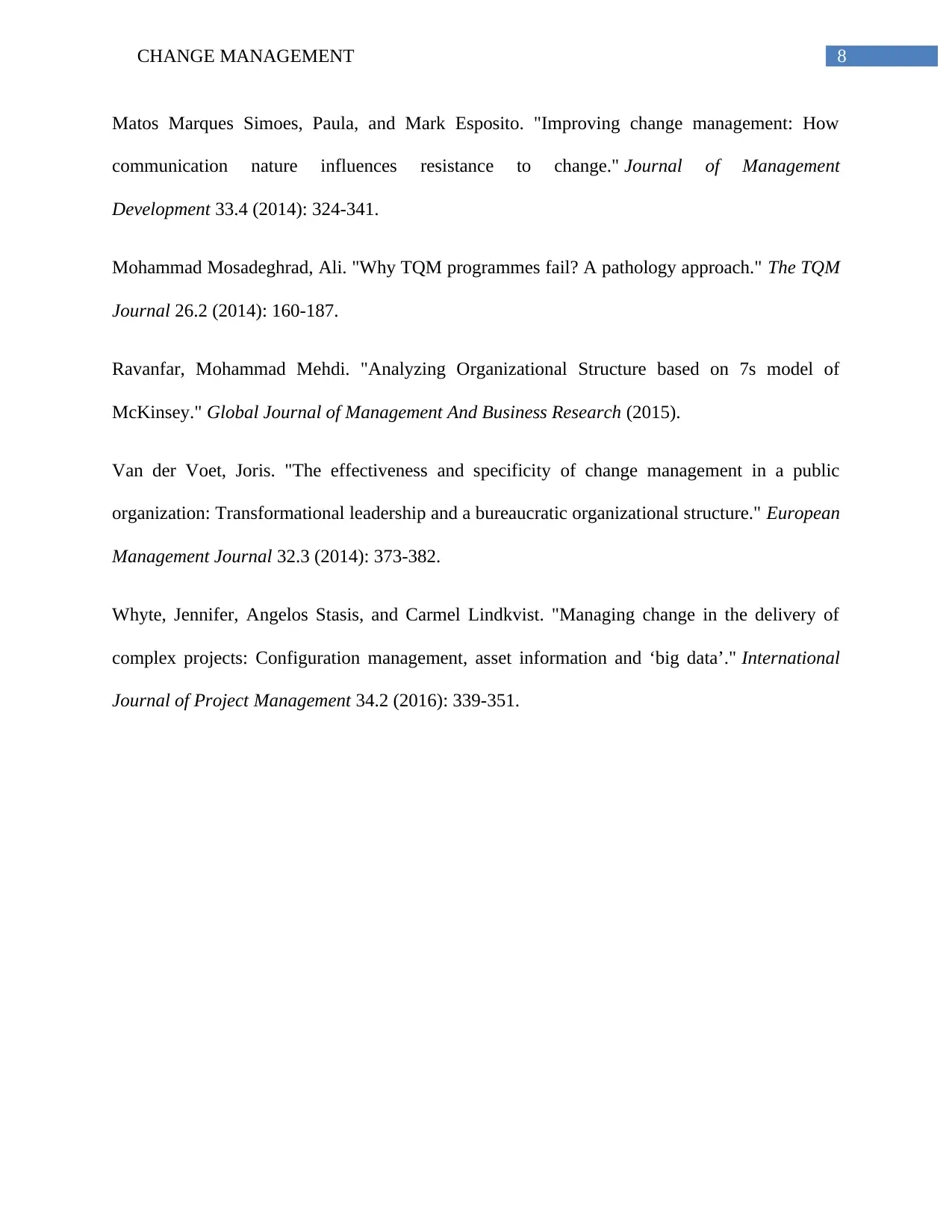
8CHANGE MANAGEMENT
Matos Marques Simoes, Paula, and Mark Esposito. "Improving change management: How
communication nature influences resistance to change." Journal of Management
Development 33.4 (2014): 324-341.
Mohammad Mosadeghrad, Ali. "Why TQM programmes fail? A pathology approach." The TQM
Journal 26.2 (2014): 160-187.
Ravanfar, Mohammad Mehdi. "Analyzing Organizational Structure based on 7s model of
McKinsey." Global Journal of Management And Business Research (2015).
Van der Voet, Joris. "The effectiveness and specificity of change management in a public
organization: Transformational leadership and a bureaucratic organizational structure." European
Management Journal 32.3 (2014): 373-382.
Whyte, Jennifer, Angelos Stasis, and Carmel Lindkvist. "Managing change in the delivery of
complex projects: Configuration management, asset information and ‘big data’." International
Journal of Project Management 34.2 (2016): 339-351.
Matos Marques Simoes, Paula, and Mark Esposito. "Improving change management: How
communication nature influences resistance to change." Journal of Management
Development 33.4 (2014): 324-341.
Mohammad Mosadeghrad, Ali. "Why TQM programmes fail? A pathology approach." The TQM
Journal 26.2 (2014): 160-187.
Ravanfar, Mohammad Mehdi. "Analyzing Organizational Structure based on 7s model of
McKinsey." Global Journal of Management And Business Research (2015).
Van der Voet, Joris. "The effectiveness and specificity of change management in a public
organization: Transformational leadership and a bureaucratic organizational structure." European
Management Journal 32.3 (2014): 373-382.
Whyte, Jennifer, Angelos Stasis, and Carmel Lindkvist. "Managing change in the delivery of
complex projects: Configuration management, asset information and ‘big data’." International
Journal of Project Management 34.2 (2016): 339-351.
⊘ This is a preview!⊘
Do you want full access?
Subscribe today to unlock all pages.

Trusted by 1+ million students worldwide
1 out of 9
Related Documents
Your All-in-One AI-Powered Toolkit for Academic Success.
+13062052269
info@desklib.com
Available 24*7 on WhatsApp / Email
![[object Object]](/_next/static/media/star-bottom.7253800d.svg)
Unlock your academic potential
Copyright © 2020–2025 A2Z Services. All Rights Reserved. Developed and managed by ZUCOL.




